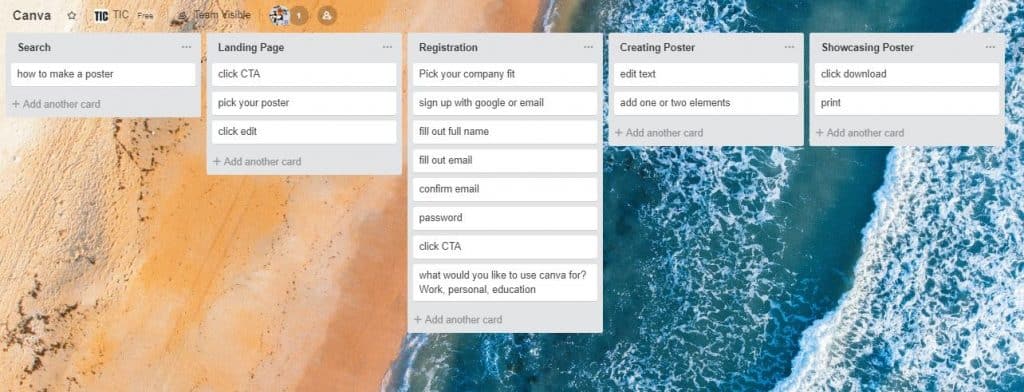Where most people go wrong in their product-led business is that they assume things. They look at their competitor who has a free trial and assume they should do the same.
But... your product, customers, and team are different. So maybe you shouldn't follow exactly what they're doing.
Disclaimer alert...
If you’re not sure whether a product-led approach is right for your business, check out this article for a decision framework.
Now that we’ve got that little disclaimer out of the way, I hope you’ve done your research and are ready to take action to launch a free trial.
Let’s dive in, shall we?
Step #1: Start with the destination in mind (7 days)
Throughout this article, I want you to pretend you’re building a highway. User onboarding can seem unnecessarily complicated, so we're going to use highways as an example to keep it simple. In this case, we’re going to build a highway from Toronto to the lovely Montreal, Canada.
Now, before we start chopping down trees to make a path for the highway, we need to ask ourselves some important questions such as:
- What is the fastest way to get people from Toronto to Montreal?
- Who should I hire or promote to help with the creation of this project?
- Are there any bottlenecks that will prevent us from building a highway to Montreal?
- Can those bottlenecks be eliminated or mitigated?
- What kind of financial investment are we going to make to not just launch this project, but also maintain it?
Just sub in Montreal with the key outcome you want people to realize in your product and re-ask yourself those questions below.
- What is the fastest way to get people to experience a key outcome in my product?
- Who should I hire or promote to tackle this project?
- Are there any bottlenecks that will prevent us from helping new users become successful in our product?
- Can those bottlenecks be eliminated or mitigated?
- What kind of financial investment are we going to make not just to launch this project, but also to maintain it?
To have a successful free trial or freemium model, you need to nail down the key outcome you want new users to experience in your product or else you’ll risk wasting your time and money.
Once you’ve nailed down your product's key outcome where your users understand the value (i.e. getting from Toronto to Montreal), you can start helping your users get there faster with the right team.
Step #2: Put the right team in place (30 days)
Transitioning from a primarily sales-led to a self-service organization doesn’t happen overnight.
You need the right people and process in place.
Unfortunately, most subscription companies just don’t have the right people or process in place so they face three options for creating a free trial:
1) Trial & Error: this option can work if you’re self-funded, but it’ll take a long time to get your self-service engine off the ground and the likelihood of you switching back to the "old way of doing things" is high. I’ve gone down this route at Vidyard and believe me when I say it feels like a magnet is drawing you to go back to the old way of doing things.
2) Hire the dream team: this option can work if resources and time aren't an issue, however, it does have its downsides. You will, no doubt, spend lots of time hiring, training your new team and getting everyone up to speed on the product. This alone can easily take most companies 60-90 days. Not to mention that finding people with this kind of relevant experience is hard. Let's face it, these people are in high demand.
3) Train your team: this option is the fastest way to get your self-service engine up and running. Think about it. Your current employees are already familiar with your product, know your customers, and (hopefully) want to see your customers succeed.
On this team, I’d recommend having these skill sets:
- Developer
- User Experience Designer
- Product Manager
- Customer Success Rep
- Digital Marketer (who’s responsible for driving free trial signups)
Just 5 people.
If you’re leading this initiative, you want to pick influential people from each team who have the power to win over others on their team. This tiger team will eventually be responsible for building out their own mini-team within your company, so choose carefully.
Once you’ve put your tiger team together, you want to give them ownership to do whatever it takes to help people become successful in the product. This could include welcoming new free trial users via snail mail, calling every signup, or even creating short personalized videos to show each user around.
At this point, it doesn't matter if it scales. All that matters is that you have a team in place that has your free trial user's back and genuinely wants to see them succeed.
One thing I will mention is that if you are going to be building a tiger team for your self-service operation, you need to play offense for them if you’re on the management team. Your new team is going, "against the grain" in your business and will no doubt get some serious kickback from the Sales team that you need to help them with. Be warned.
Once you’ve identified and trained your team, you can figure out how to improve your self-service experience (without committing a single line of code).
Step #3: Clear the path (7 Days)
While we can try to motivate users to complete actions, it’s often easier and more cost-effective to optimize your free trial experience.
Any product that significantly reduces the steps to complete a task will enjoy high adoption rates.
Does Amazon’s One-Click buy button ring a bell for you? 🙂
One of the easiest ways to optimize your self-service model for conversions is to do user journey mapping. In a nutshell, user journey mapping involves documenting every step it takes to get to the destination or key outcome of your product.
For instance, if you Google “how to create a poster” and click the Canva link, these are all the steps it takes to create your first poster.

If this is your first time going through the process of your product, you’ll probably find that there are lots of steps you might be able to eliminate altogether so that you can enjoy higher adoption rates.
At the end of the day, although user journey mapping can be really helpful if you do it yourself, it’s often a lot more insightful if you get new users to go through the experience.
Now, back to the highway analogy.
Step #4: Create the highway to your destination (30 days)
Creating a highway to your destination (a.k.a key outcome in your product) is a shortcut for your user. Yes, they could get to their destination by taking small roads off the beaten path, but it would take them way longer, and lots of people would get lost.
Most subscription businesses do exactly this and lose a lot of people. In fact, Intercom claims that as many as 60% of users who sign up for a free trial of your SaaS app will use it once and never come back.
As a business owner, that’s like lighting 60% of your capital on fire.
If you want to avoid that sad reality, you NEED to nail the first experience for each user.
That means your highway needs to be well-lit, easy to find, use lots of signs, and have off-ramps that will launch your user into other areas of your product.
By this point, your tiger team will be able to do a lot of the heavy lifting and help your users get to their destination faster. They’ll be able to do this by experimenting with elements in and out of the product that will help drive product adoption and get your user to their destination.
Here’s just a sneak peek at some of the options your team can use to help users become successful:
Step #5: Optimize for conversions (15 days)
I often get asked why I optimize for conversions last.
Why not first?
Well, I’d rather push a rock down a hill than up one if I'm being honest. What I mean by this is that whenever you’re creating a self-service engine, you want to focus on helping your users become successful first, and then optimizing for conversions becomes easy.
If you start off your free trial with BUY BUY BUY banners everywhere and do absolutely nothing to help your user get to their destination...
Good luck my friend.
You’re going to scare away your users and never see them again.
If you want to learn how to optimize for conversions the right way, this article dives deep on how to convert free trial users into customers.
Tying it all together
Launching a world-class free trial in 90 days is no small feat.
However, if you do build out a free trial you’re not just transforming the way you sell, you're building a moat around your business.
This moat can afford you some nice perks such as:
Wider top-of-funnel: By having a free trial or freemium model, you are opening your funnel up to people who are earlier on in their customer journey. This is powerful because instead of having potential prospects fill out your competitor’s demo request, they are spending time evaluating your product for themselves.
Rapid global scale: While your competitors are busy hiring new sales reps for each region under the sun, you can focus on improving your onboarding so that you can service more customers easily across the world in a fraction of the time.
Fast sales cycles: By having your prospects onboard themselves in your product, you can significantly reduce your prospect’s time to value and sales cycle. Once people experience value in your product, the next logical thing to do is upgrade.
High revenue per employee (RPE): Software was always built to scale well, but with a self-service approach, you’re able to do more with fewer people on your team. Fewer support requests and less hand-holding means higher profit margins per customer.
So, what are you waiting for?
Don't forget about the landing page
One of the most crucial elements in launching a SaaS free trial is the landing page. This is what motivates website visitors to signup in the first place. ProductLed Acquisition is our live 4-week program that will teach you how to create high-converting SaaS landing pages from scratch.
The program is spread across four weeks:
- Week 1: Positioning – which features should go on my page and which shouldn’t?
- Week 2: Structure – What does the perfect structure look like for my page?
- Week 3: Headlines – How do I write high-converting headlines?
- Week 4: Finishing Details – How do I create the right visuals without a designer?
Along the way, we provide proven frameworks and formulas so you can create new copy in minutes with examples.
We host Zoom workshops every Tuesday throughout the program where you will write copy during the 2-hour session. You get access to unlimited async for feedback on your copy during the program from the King of B2B SaaS Writing Pedro Cortes himself. Plus, you have access to all course materials for a year. Enroll today in our next cohort.






